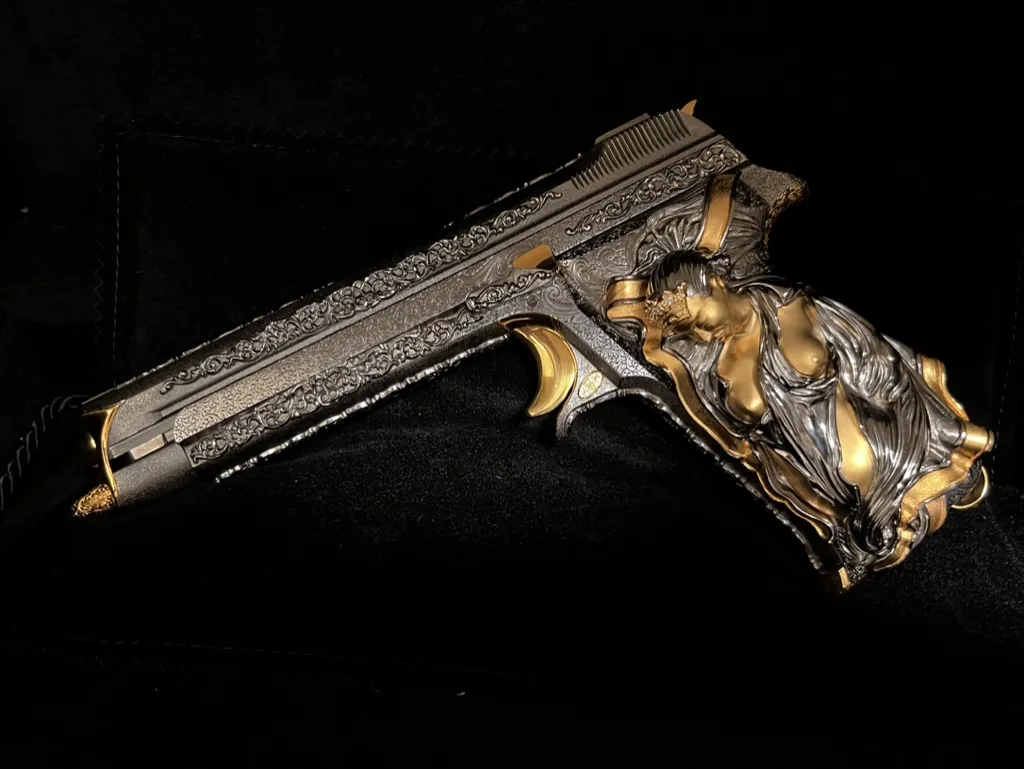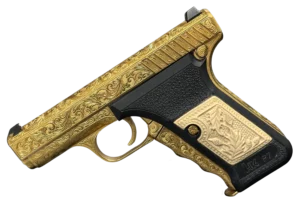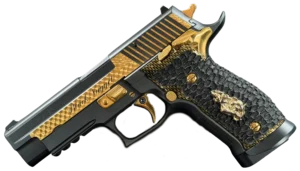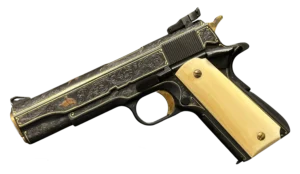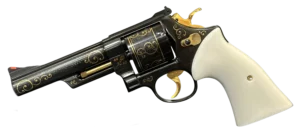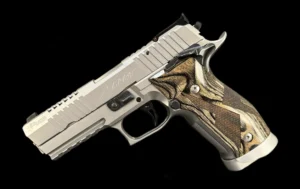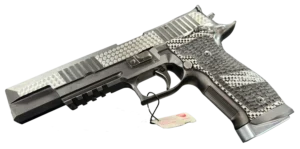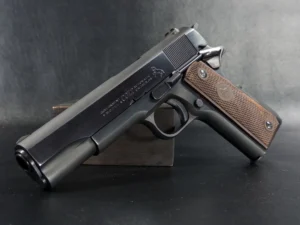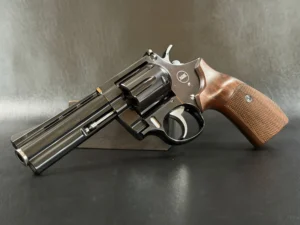Key Takeaways:
- Luxury firearms aren’t just tools—they’re mechanical art with soul: Whether it’s a Cabot 1911 crafted from meteorite or a Mueller Murgenthal revolver with FEGA-certified engraving, high-end guns tell a story far beyond ballistics. They’re built with the same obsessive care and detail as fine watches or sculptures—and often, with more fire.
- The connection between guns, watches, and sculptures runs deeper than you’d think: Precision mechanics, timeless design, emotional value—it’s all there. A SIG Sauer Mastershop pistol whispers class in the same way a Patek Philippe does. The artistry behind a gold-inlaid Korth shares DNA with bronze castings and gallery work. They’re different media, but the same language.
- Owning a luxury firearm is about passion, presence, and—yes—portfolio: These aren’t just weekend shooters. They’re investment-grade collectibles, heirlooms, and sometimes even centerpieces of identity. Like a rare Rolex or a limited-edition sculpture, they represent obsession made tangible—and if you ask their owners, they’re worth every ounce of steel and swagger.
Let’s get something straight from the start—when we talk about luxury firearms, we’re not talking about your off-the-shelf 9mm tucked into a nightstand. We’re talking about mechanical poetry. Guns have more in common with Rolex watches and bronze sculptures than with polymer sidearms. Guns like a Cabot Damascus 1911. A Mueller Murgenthal triple lock. Or a SIG Sauer Mastershop X-Series pistol with a gold-plated skeleton slide. These aren’t just tools—they’re works of art, and they deserve to be spoken of in the same breath as the finest horology and sculpture.
The Craft of Bang: What Makes a Firearm ‘Luxury’?
Luxury firearms don’t just shoot bullets—they tell stories. Every curve of a Korth revolver, every gold inlay on a SIG Mastershop, speaks to a tradition of elite craftsmanship. Sure, you could say it’s about materials (and yes, stainless billet, mirror-polished carbon steel, and exhibition-grade walnut grips do play their part), but it’s more than that. It’s about the level of finish that you can’t unsee once you’ve seen it. The kind that makes you whisper, “This shouldn’t be legal,” the first time you pull the trigger.
What sets them apart? Three things:
- Precision, but personal. Most luxury firearms are handmade or hand-finished. You can feel it.
- Performance beyond reason. The tolerances are so tight that some guns feel vacuum-sealed when you rack the slide.
- Design for the eyes and the hands. It has to shoot beautifully. But it also has to look like it costs more than your car.
Take Cabot Guns. Known for using meteorite, Damascus steel, and even 24K gold in limited editions, their 1911s are engineered not just to function flawlessly but to mesmerize. Or the Korth PRS—a German-made marvel that blends the soul of 1911 with aerospace-level fit and finish. These aren’t just pistols. They’re heirlooms.
The same goes for Mueller Murgenthal revolvers, often built in collaboration with master engravers. Each one is essentially a limited production sculpture that just happens to be chambered in a .357 Magnum. Some even include embellishments like unicorn engravings or gold oak leaves—elements you’d expect on a Fabergé egg, not a sidearm.
Tick Tock, Meet Click Clack: Firearms vs Luxury Watches
Now let’s talk watches. You know the names: Rolex, Patek Philippe, Audemars Piguet. What they do with time, luxury guns do with pressure, velocity, and recoil. There’s a shared DNA: precision mechanics, timeless appeal, and an obsessive attention to detail that borders on madness.
Both watches and firearms rely on complicated internals that demand meticulous assembly. The escapement on a mechanical watch? That’s your sear engagement in a tuned 1911 trigger job. A screw-down crown? That’s your compensator threads.
More importantly, both categories stir the same human urge: to own something mechanically perfect. Something eternal. Something that whispers, “Yes, this was made for you and only you.”
Have you ever seen the backplate of a skeletonized tourbillon and thought, “How is this even possible?” Now look inside a SIG P226 X-Five Skeleton, and you’ll find yourself saying the exact same thing.
One keeps time. The other takes it.
And let’s not ignore what a luxury watch says about status, especially in collectors’ circles. The same conversations take place around firearms. The man wearing a limited-edition Audemars Piguet may also be the guy who owns a SIG Mastershop “Violine” P226 with custom Cocobolo grips and a gold-plated slide.
Just as collectors obsess over dial variations, serial ranges, and provenance in watches, gun enthusiasts get equally granular about frame generations, barrel lengths, and factory test targets. Even a worn blueing can tell a story—just like the patina on a well-loved Rolex Submariner.
Bronze and Steel: Firearms vs Fine Art and Sculpture
Let’s stretch even further. What if we compared a firearm to a piece of sculpture? Think that’s too far? Not if you’ve ever seen a FEGA-certified, deep-relief hand-engraved revolver glinting under the lights of a collector’s show. Not if you’ve ever held a gold inlaid P210 and realized you’re touching hours—no, weeks of someone’s soul in metal.
Sculptures are often admired from a pedestal. Luxury firearms, too, often never get fired. They rest in walnut display boxes or museum-grade safes. But just like a sculpture, every curve and angle is intentional. Every engraving is a brushstroke in steel.
There’s a conversation happening in each piece: an exchange between artist and owner. Sometimes, the metal is signed, like a chisel mark on a Rodin bust. Sometimes, it’s hidden, like a small flourish in the corner of a revolver’s frame. Either way, that intimacy creates value—not just financial, but emotional.
Collectors often refer to their finest guns the way one might talk about an heirloom painting. “This belonged to…” or “It’s one of only three ever made.” These aren’t objects of utility—they’re objects of permanence.
Cabot Guns: Where Engineering Meets Ego
Cabot is a perfect example of this new breed of gunmaker that understands its clientele doesn’t just want performance. They want presence. And that means steel that’s mirror-polished, custom-fitted safeties, and grip scales cut from a mammoth tusk.
They’re the firearm equivalent of a bespoke suit—tailored, unforgettable, and just a little bit cocky.
Their Jones 1911, built from a 4.5-billion-year-old meteorite, sold for six figures. Was it meant to be carried? Absolutely not. Was it meant to be admired, envied, and gawked at? You bet.
And yet, Cabot’s pistols still perform at a match level. Because of their philosophy, beauty is the point, but it means nothing if it doesn’t shoot like a dream.
Cabot guns tend to have names, not model numbers. And that says something about their customers: they’re buying character, not just capability. Even the packaging—a box that’s more presentation case than carry case—hints at the experience being something closer to luxury jewelry than military hardware.
SIG Sauer Mastershop: German Discipline, Unchained
While Cabot leans into American swagger, SIG Sauer’s Mastershop division represents the exacting precision of European discipline. Located in Eckernförde, Germany, the Mastershop Shop builds firearms that marry Olympic-grade accuracy with gallery-level artistry.
Take the P226 X-Five Skeleton or the Scandic editions with gold inlays and birch grips. These guns aren’t just assembled—they’re curated. Built-in small batches, often with component tolerances measured in microns, each pistol is both a precision machine and a design object.
They also offer a kind of restraint not seen in many modern guns. Even when adorned with ornate gold, the finish never tips into gaudy. They feel ceremonial without being performative. A SIG Mastershop pistol is a nod, not a shout.
Collectors whisper about Mastershop models like sommeliers whisper about rare vintages. They compare production years, grip options, and slide serration patterns. The community around them is one of reverence, not just ownership.
Owning a Luxury Firearm: Passion or Portfolio?
So, is owning a luxury firearm about passion? Or is it about investment?
Honestly—both. Like rare watches or fine art, many high-end guns appreciate in value. Limited runs, historical tie-ins, or discontinued masterpieces like the Korriphila HSP 701 can skyrocket at auction. Some collectors buy with their hearts. Others with their heads. But the smartest do both.
And there’s something to be said for the feeling of owning one. The smell of finely machined steel. The weight of something made with care. That moment when you open a custom-fit case and see a work of functional art looking back at you.
You can’t hang it on the wall like a painting (though some do). But it sits in your safe like a crown jewel. Waiting. Commanding respect.
So, Which Is Better?
Let’s not pretend this is an apples-to-apples thing. A Rolex doesn’t bark fire. A sculpture can’t group sub-MOA. And a gun isn’t always welcome in polite company (though, frankly, neither is a six-figure watch if you wear it just to flex).
The difference lies in use. A luxury watch is worn. A sculpture is shown. A luxury firearm is held, admired, and, if you’re lucky, fired.
But all three are reflections of their owner. They signal taste, obsession, and appreciation for the beautiful, the rare, and the made well.
You don’t need to choose between a Mueller Murgenthal and a Patek Philippe. But if you had to, well—one makes you late for dinner. The other might just start it.
And maybe that’s the final truth here: luxury isn’t defined by category. It’s defined by emotion. By obsession. By the small, quiet moments when you look at something and say, without hesitation, this is mine.
Frequently Asked Questions
It’s not just about price—it’s about craftsmanship, materials, and the experience it delivers. A luxury firearm like a Korth, Cabot, or SIG Mastershop is often handmade, highly tuned, and aesthetically elevated. Think mirror-polished steel, exotic wood grips, gold inlays, and tolerances tighter than a Swiss watch.
Absolutely. Like a Rolex or a fine bronze, luxury guns represent a fusion of engineering and artistry. They’re built to last, designed to impress, and often crafted in limited numbers. Both categories are admired for mechanical perfection, emotional appeal, and status signaling.
Both. Some are tucked away in safes or shown off in custom cases. Others—like many Cabots or Mastershop SIGs—are also range-ready and capable of outshooting most production pistols. But whether you fire them or frame them, the admiration is the same.
They can be. Limited production runs, rare engravings, and historical significance—these factors often make high-end guns appreciate over time. But like watches and art, value isn’t just about money. It’s about connection, story, and the sheer joy of ownership.
Collectors, enthusiasts, artisans-at-heart—and yes, investors. Some want a crown jewel in their collection. Others are drawn to the mechanical elegance. And a few just like the feeling of owning something rare, beautiful, and functional. It’s not about “needing” it. It’s about wanting it.


